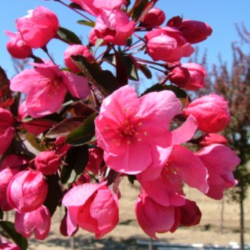Description
Key Features:
Size & Growth: The Amur Cherry typically reaches a height of 20 to 30 feet with a spread of 15 to 20 feet. It has a compact, rounded form, making it suitable for smaller gardens or as a focal point in larger landscapes.
Foliage: Features dark green, ovate leaves that turn a rich golden-yellow to orange in the fall, providing a vibrant display of autumn color. The foliage is dense and provides a nice canopy of shade.
Flowers: In early spring, the tree produces clusters of small, fragrant white flowers that bloom before the leaves fully emerge. These blossoms attract pollinators such as bees and butterflies, adding both beauty and ecological value to your garden.
Bark: One of the standout features of the Amur Cherry is its distinctive bark. As the tree matures, the bark exfoliates in thin, papery strips, revealing a rich, golden-brown inner layer. This exfoliating bark provides visual interest throughout the winter months.
Fruit: The tree produces small, dark red cherries that are not particularly edible for humans but can attract birds and other wildlife, adding an additional layer of interest to the landscape.
Disease Resistance: The Amur Cherry is generally resistant to common pests and diseases, including powdery mildew and cherry leaf spot. Its hardiness makes it a low-maintenance addition to your garden.
Soil & Light Requirements: Prefers well-drained soil and thrives in full sun to partial shade. It is adaptable to various soil types, including sandy, loamy, and clay soils, and can tolerate urban conditions.
Care Instructions: Requires minimal maintenance once established. Regular watering during the first growing season helps the tree establish a strong root system. Once mature, it is relatively drought-tolerant but benefits from occasional watering during extended dry periods. Pruning is generally not necessary but can be done to shape the tree or remove any dead or damaged branches.
Uses:
Ornamental: Ideal for adding visual interest and seasonal color to garden beds, parklands, and urban landscapes. Its striking bark and vibrant foliage make it a standout feature in any setting.
Specimen Tree: Perfect as a focal point or specimen tree in larger gardens or landscape designs where its beauty can be fully appreciated.
Wildlife: Provides habitat and food for birds and other wildlife, enhancing the ecological value of your garden.
Planting & Maintenance:
Planting: Choose a location with well-drained soil and adequate sunlight. Dig a hole that is twice the width of the root ball and plant the tree at the same depth it was growing in the container. Space multiple trees about 15 to 20 feet apart to allow for their mature size.
Watering: Water thoroughly after planting and keep the soil consistently moist during the first growing season. Once established, the tree requires less frequent watering but should be monitored during dry spells.
Pruning: Minimal pruning is needed. Remove any dead or damaged branches and shape the tree as desired in late winter or early spring before new growth begins.
Enhance your garden with the distinctive charm of the Amur Cherry. Its striking bark, beautiful blooms, and vibrant fall color make it a unique and attractive addition to any landscape, providing year-round interest and beauty.





